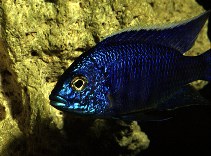| Family: |
Cichlidae (Cichlids), subfamily: Pseudocrenilabrinae |
| Max. size: |
14.6 cm TL (male/unsexed) |
| Environment: |
benthopelagic; freshwater |
| Distribution: |
Africa: Endemic to Lake Malawi. Occurs on the southern half of the lake (Mbenji Islands Nakatenga and Maleri Islands, Nkhomo Reef near Benga and Eccles Reef south of Makanjila, on the eastern coast). |
| Diagnosis: |
Dorsal spines (total): 15-18; Dorsal soft rays (total): 10-12; Anal spines: 3-3; Anal soft rays: 8-9. Diagnosis: 3 lateral spots on the body; supra-pectoral spot about 1.5 times the supra-anal spot; supra-pectoral spot separate from upper lateral line; supra-anal spot smaller than 2 scales; males in breeding coloration with blue breast, narrow yellow marginal band in anal fin and without spots or streaks in the anal fin (Ref. 57549).
Description: dorsal snout profile straight; gape inclination of mouth about 40° to horizontal; jaws isognathous; teeth on dentary and premaxilla in 3-4 rows, outer row teeth unicuspid and somewhat enlarged in mature males (> 80 mm SL) and bicuspid in females and immature males; lower pharyngeal jaw small, dentigerous area notched posteriorly, with bicuspid teeth, all small or with few median teeth slightly enlarged; gill-rakers on ceratobranchial short and slender; 3-4 teeth rows in upper and lower jaw; 2-3 scale rows on cheek; 1-2 pored scales posterior to lateral line (Ref. 57549).
Coloration: breeding males: head blue with green highlights; interorbital blue with light-blue highlights; blue opercle; throat gray with blue highlights; lateral portion of body dark blue ground color dorsally, fading to blue/gray ventrally, with 8 dark gray bars; breast and belly greenish blue with dark-gray markings; dorsal fin dark blue with green and light-blue highlights and a white marginal band with yellow/white lappets; caudal fin with blue rays and blue/green membranes, distal 1/4 dark gray; anal fin blue to green/blue with very narrow marginal orange/yellow band; pectoral fin with gray rays and clear membranes; pelvic fin with blue/green rays and blue/gray membranes (Ref. 57549). Females: head gray dorsally, fading to white ventrally; blue and silver highlights on cheek; throat white; lateral portion of body gray/blue ground color with anterior portion of scale outlined in orange/yellow; 3 distinct black spots on lateral portion of body; supra-pectoral spot below 10-12th scale not in contact with upper lateral line and about 1.5 times size of supra-anal spot; supra-anal spot at 23-25th scale above and in contact with lower lateral line and covering less than 2 scales; caudal spot same diameter as supra-anal spot on caudal base; 8 gray bars and white belly with gray highlights; 3 vertical bars between supra-pectoral spot and dorsal fin origin; dorsal fin clear with pale orange/gray vermiculations in rayed portion and orange lappets; caudal fin with clear rays and orange/gray membranes; anal fin clear with scattered micromelanophores, 6-8 pale orange ocelli and orange lappets between rays; pectoral fin clear; pelvic fin clear with light-gray membrane between first and second ray (Ref. 57549). |
| Biology: |
Inhabits the sand/rock interface; territorial males defend their bower with a bowl in front of a spawning cave that spans about half a circle or less, about 19-33cm in diameter; females gather in small groups or are solitary, and feed from the plankton and benthic invertebrates near the bottom (Ref. 57549). Aquarium trade names: 'Haplochromis chrysonotus mbenji', 'Haplochromis chrysonotus maleri' (Ref. 5595). |
| IUCN Red List Status: |
Near Threatened (NT); Date assessed: 22 June 2018 (B1a+2a) Ref. (130435)
|
| Threat to humans: |
harmless |
| Country info: |
|
Source and more info: www.fishbase.org. For personal, classroom, and other internal use only. Not for publication.

